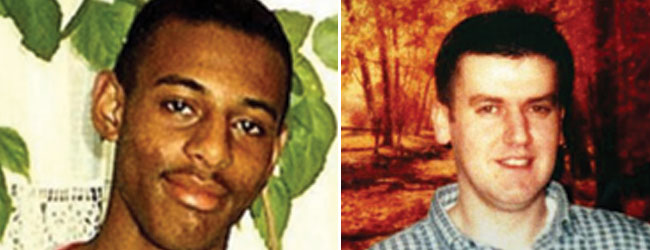6 February 2012
Stephen Lawrence and Robert Hamill cases - Getting away with murder?
INSTITUTIONAL RACISM IN LONDON’S METROPLITAN POLICE | INSTITUTIONAL SECTARIANISM IN THE ROYAL ULSTER CONSTABULARY
» BY PEADAR WHELAN
- Stephen Lawrence and Robert Hamill
AFTER nearly 19 years of campaigning, the family of black teenager Stephen Lawrence, stabbed to death in an attack by a gang of racist white youths in south London in 1993, have, at long last, won some measure of justice.
On Wednesday 4 January, Gary Dobson and David Norris were handed down prison sentences at the Old Bailey of 15 and 14 years respectively.
Justice Treacy described Stephen’s killing as “a terrible and evil crime”, adding: “A totally innocent 18-year-old on the threshold of a promising life was brutally cut down in the street in front of eyewitnesses by a racist, thuggish gang.”
Stephen’s father, Neville Lawrence, described the outcome as “only one step in a long, long journey”.
The Lawrence family was convinced the Metropolitan Police’s handing of the initial investigation was nothing short of a travesty.
In 1997, newly-elected British Labour Party Home Secretary Jack Straw ordered an inquiry headed by Sir William MacPherson to examine the case and how it had been handled.
MacPherson’s findings, published in 1998, forced Paul Condon, the then Metropolitan Police Commissioner, to admit that “institutional racism” within the police lay behind the failure of the investigation into the Lawrence killing.
Stereotyping of particular communities as
as potential criminals or troublemakers and a police canteen culture can be a “breeding ground” for this type of racism, leading to failures in policing, MacPherson asserted.
In the mid to late 1990s, as the British political, policing and judicial establishment was struggling to confront the worst excesses of its “institutional racism”, and Jack Straw was ordering the MacPherson Inquiry, the family of Portadown man Robert Hamill was confronting the institutional sectarianism of the RUC.
Robert Hamill, a 25-year-old Catholic man from the north Armagh town, was returning from a night out with friends when he was attacked by a loyalist mob. The attack was carried out under the gaze of an RUC mobile patrol. Four armed members of the RUC sat in their armoured Land Rover and watched as the loyalist thugs viciously laid into Robert and his companions.
This was on 28 April 1997. Robert died 12 days later, on 8 May. He never recovered consciousness.
As Britain faced up to ‘institutional racism’ in the police, the family of Portadown man Robert Hamill was confronting the institutional sectarianism of the RUC
His sister, Diane, summed up the family’s need for justice with a quote from her mother, Jessie, who, on hearing of the attack on Robert, said: “Robert was beaten up, the police were there and they didn’t help him.”
Not only did the RUC not come to the aid of Robert Hamill and his companions, they tried to brush the killing under the carpet. Initially they presented the incident as a fight between two factions and that members of the RUC were themselves assaulted when they intervened. At the scene of the incident an eyewitness identified one of the attackers to an RUC officer. This RUC member refused to act on the information.
It also emerged in the aftermath of the fatal attack on Robert Hamill that one of those in the patrol shared membership of a martial arts club with one of the assailants. It transpired that this RUC member may have advised the assailant to destroy the clothes he was wearing on the night of the attack.
Forced by public opinion and the determination of the Hamill family, supported by their friends and neighbours in Portadown, the RUC eventually arrested and charged six men with murder. Just one, Paul Hobson, was convicted of the minor offence of affray. The others were acquitted.
‘Robert was beaten up, the police were there and they didn’t help him’ — Robert Hamill’s family
The disquiet surrounding the Hamill case and the allegations of collusion between the RUC and the loyalists ensured that it was investigated by Canadian Judge Peter Cory in his 2004 report into collusion.
Despite this and the public inquiry, chaired by Sir Edwin Jowett, no one has been convicted of the killing of Robert Hamill.
The Public Prosecution Service has, however, confirmed that, following a review of all the available evidence including that given to the Hamill Tribunal, it has concluded that the Test for Prosecution is met in respect of two persons for an offence of conspiracy to pervert the course of justice and one person for an offence of doing an act with intent to pervert the course of justice. This is hardly a ringing endorsement of the previous record of the RUC or PSNI, nor indeed the judicial system.
The similarities between the Lawrence and Hamill killings show the racist/sectarian undercurrents in the ranks of the London’s Metropolitan Police and the RUC. And despite the hand-wringing and moralising of the Establishment, the reality is that sectarian and racist thugs seem to have got away with murder in the case of Robert Hamill.
Billy Bragg sums it up in his song The Few:
And the society that spawned them
Just cries out ‘Who’s to blame?’
And then wraps itself in the Union Jack
And just carries on the same
Follow us on Facebook
An Phoblacht on Twitter
Uncomfortable Conversations

An initiative for dialogue
for reconciliation
— — — — — — —
Contributions from key figures in the churches, academia and wider civic society as well as senior republican figures





